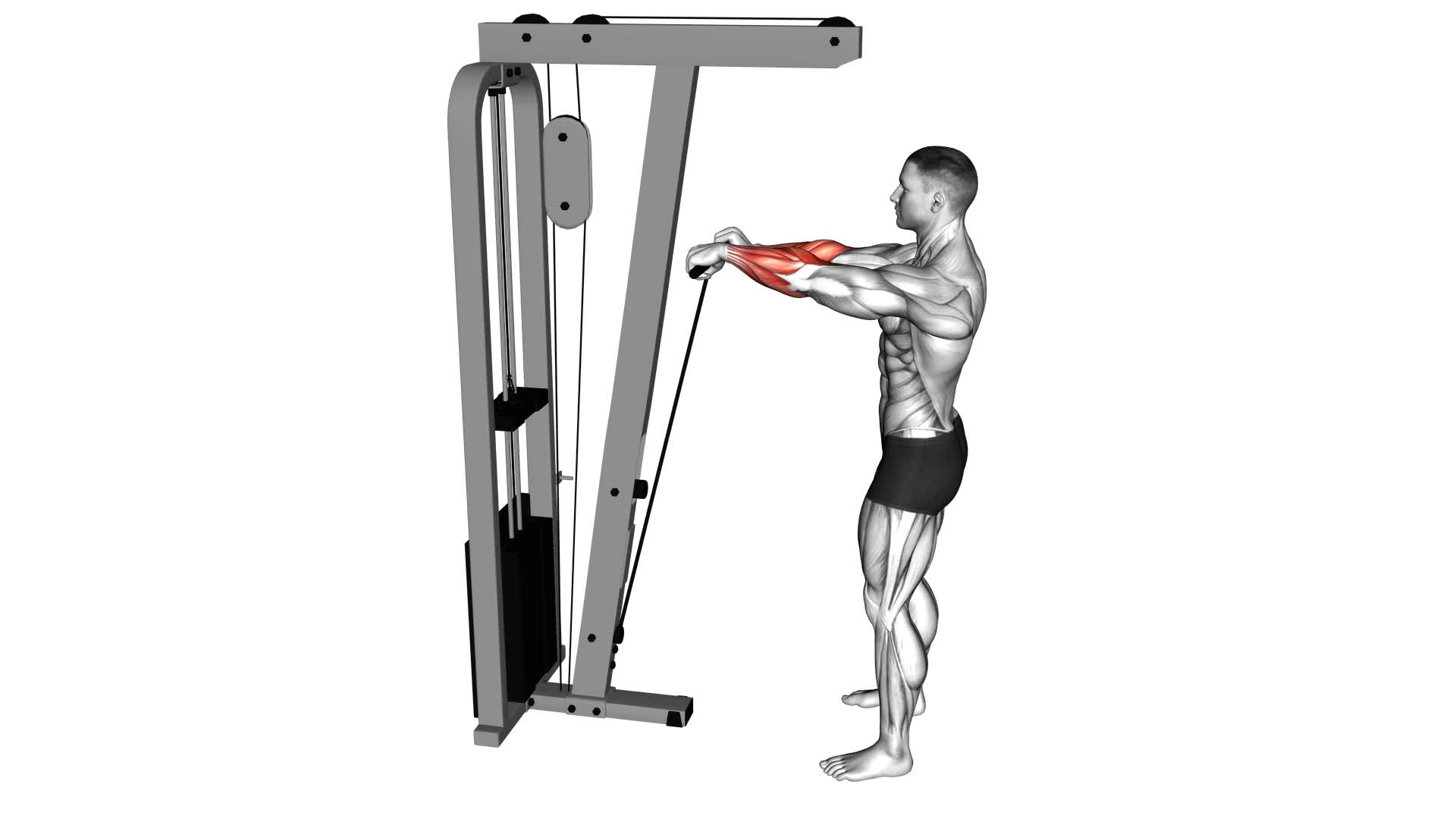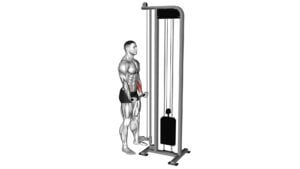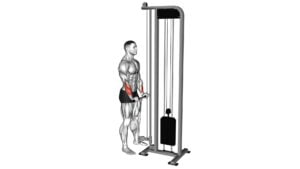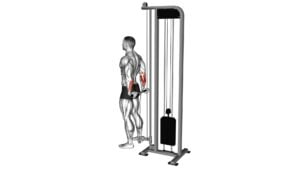Cable Standing Wrist Roll – Video Exercise Guide & Tips

Are you looking for a new exercise to strengthen your wrists? Look no further than the Cable Standing Wrist Roll!
Watch This Exercise Video
In this video exercise guide, we'll show you the proper form and technique to maximize your results.
With variations and progressions to challenge yourself, and tips to avoid common mistakes, you'll be well on your way to stronger wrists in no time.
So grab a cable and let's get started!
Key Takeaways
- Cable standing wrist roll strengthens wrists and improves grip strength.
- It enhances overall upper body strength and stability.
- The exercise targets muscles in the forearms and wrists.
- It increases endurance and power in the wrists and improves grip strength for activities like weightlifting and rock climbing.
Benefits of Cable Standing Wrist Roll
To strengthen your wrists and improve grip strength, the benefits of the Cable Standing Wrist Roll exercise are worth exploring. Wrist strengthening exercises are essential for enhancing overall upper body strength and stability. The Cable Standing Wrist Roll specifically targets the muscles in your forearms and wrists, helping to increase their endurance and power. By incorporating this exercise into your workout routine, you can expect to see improvements in your grip strength, which can have a positive impact on various activities such as weightlifting, rock climbing, and even everyday tasks like opening jars or carrying heavy objects.
One of the main benefits of wrist strengthening exercises like the Cable Standing Wrist Roll is the prevention of injuries. Strong wrists can help reduce the risk of sprains, strains, and fractures, especially during activities that involve repetitive wrist movements or heavy lifting. Additionally, having strong wrists can also enhance your overall athletic performance, as it allows for better control and stability during exercises that require grip strength, such as pull-ups or deadlifts.
Furthermore, the Cable Standing Wrist Roll exercise can also help improve your forearm aesthetics. As you engage in this exercise regularly, you'll notice increased muscle definition and tone in your forearms, giving them a more sculpted and athletic appearance.
Equipment Needed for Cable Standing Wrist Roll
To successfully perform the cable standing wrist roll exercise, there are a few essential pieces of equipment you'll need. Firstly, you'll need access to a cable machine with a low pulley attachment.
Additionally, you'll need a straight bar or rope attachment to grasp onto during the exercise.
It's important to ensure that the equipment is properly set up and adjusted for your height and comfort before starting the exercise.
Essential Equipment for Wrist Roll
To perform the Cable Standing Wrist Roll exercise, you'll need a cable machine and a wrist roller attachment. The cable machine provides the necessary resistance for the exercise, while the wrist roller attachment allows you to grip the weight and roll it up and down.
Here are three essential pieces of equipment for wrist roll exercises:
- Cable machine: This machine provides a constant tension throughout the exercise, allowing you to strengthen your wrists effectively.
- Wrist roller attachment: This attachment is specifically designed for wrist roll exercises. It allows you to hold onto the weight and roll it up and down, targeting the muscles in your wrists and forearms.
- Weight plates: These are used to add resistance to the exercise. Start with a weight that challenges you but still allows you to maintain proper form.
Alternatives to Cable Machine
If you don't have access to a cable machine, you can still perform the Cable Standing Wrist Roll exercise using alternative equipment. There are several options you can consider as cable machine alternatives for this exercise.
One option is to use a resistance band. Simply attach the band to a sturdy anchor point, such as a door handle or a pole, and hold the other end of the band with your hands.
Another alternative is to use dumbbells or barbells. Hold the weights with an overhand grip and roll them up and down using your wrists.
You can also use a kettlebell, gripping the handle with both hands and rolling it up and down.
These wrist roll variations provide similar benefits to the cable machine exercise and can be effective alternatives if you don't have access to one.
Safety Precautions for Wrist Roll
To ensure your safety and effectively perform the Cable Standing Wrist Roll exercise, it's important to have the necessary equipment. Here are some safety tips and precautions to keep in mind while doing wrist roll exercises:
- Use a cable machine with adjustable weight settings to ensure proper resistance for your fitness level.
- Attach a wrist roller handle to the cable machine, making sure it's securely fastened.
- Before starting the exercise, adjust the cable machine height to your comfort level and ensure there's enough space around you to perform the movement safely.
Following these safety precautions will help minimize the risk of injury and allow you to fully focus on strengthening your wrist and forearm muscles.
Remember to start with lighter weights and gradually increase the resistance as you progress in your training. Always listen to your body and stop if you experience any pain or discomfort.
Proper Form and Technique for Cable Standing Wrist Roll
Start by gripping the cable handle with an overhand grip at waist height. This grip ensures that you have full control over the cable and allows for proper execution of the exercise.
The cable standing wrist roll is an effective exercise for strengthening the muscles in your forearms and improving grip strength. To perform the exercise, stand with your feet shoulder-width apart and maintain a slight bend in your knees. Keep your core engaged and your back straight throughout the movement.
To begin, extend your arms fully in front of you, keeping your wrists straight. Slowly roll the cable handle towards your body by flexing your wrists. Make sure to keep your elbows stationary and avoid any jerky movements. As you roll the cable, focus on squeezing your forearm muscles and feeling the tension in your wrists. Pause for a moment at the top of the movement, then slowly reverse the motion to return to the starting position.
When performing the cable standing wrist roll, it's important to avoid common mistakes. One common mistake is using too much weight, which can lead to improper form and strain on the wrists. Start with a lighter weight and gradually increase as you become more comfortable with the exercise.
Another mistake is allowing your wrists to bend or rotate during the movement. Keep your wrists straight and locked in position throughout the exercise to maximize its effectiveness. Remember to maintain proper form and technique to get the most out of the cable standing wrist roll.
Variations and Progressions for Cable Standing Wrist Roll
Now that you have mastered the proper form and technique of the cable standing wrist roll, it's time to take it to the next level with some advanced variations and progressions.
One option is to try the advanced wrist roll, which involves increasing the resistance level and challenging your forearm muscles even further.
Another way to vary the exercise is by adjusting the resistance level, using heavier or lighter weights to target different muscle fibers.
Lastly, don't forget to focus on refining your technique to ensure maximum effectiveness and minimize the risk of injury.
Advanced Wrist Roll
Once you have mastered the basic Cable Standing Wrist Roll exercise, you can advance to various variations and progressions to further challenge your wrist strength and improve overall forearm development.
Here are some advanced wrist exercises you can try:
- Reverse Wrist Roll: Instead of rolling the cable towards you, roll it away from you. This targets the muscles on the back of your forearm.
- Single Arm Wrist Roll: Perform the exercise with only one arm at a time, allowing for greater focus and intensity on each wrist.
- One-Arm Eccentric Wrist Roll: Slowly lower the weight back down after each roll, emphasizing the eccentric phase of the movement. This increases time under tension and enhances muscle growth.
Resistance Level Variations
To further challenge your wrist strength and enhance forearm development, incorporate resistance level variations into your Cable Standing Wrist Roll exercise. By making resistance level adjustments, you can modify the intensity of the exercise and target different muscle fibers in your forearms.
Start by using a lighter resistance and gradually increase it as your wrist strength improves. This will ensure progressive overload and continued growth and development.
You can also try using different attachments or grips to change the angle and stress on your wrists and forearms. Experiment with different wrist roll modifications, such as using one hand at a time or performing the exercise with a pronated or supinated grip. These variations will challenge your muscles in different ways and promote well-rounded forearm development.
Now, let's move on to the next section to learn about technique refinements.
Technique Refinements
To refine your technique for the Cable Standing Wrist Roll, try incorporating variations and progressions to target different muscles and continue challenging your forearm development. Here are some techniques you can use to improve your performance:
- Reverse Grip: Instead of using an overhand grip, try using an underhand grip. This variation targets the muscles in your forearms from a different angle, providing a new challenge for your wrist roll exercise.
- Single Arm Roll: Perform the wrist roll exercise with one arm at a time. This variation helps to isolate each forearm individually, allowing for more focused and targeted training.
- Slow Eccentric: Instead of rolling the cable up quickly, focus on lowering it down slowly and controlled. This variation emphasizes the eccentric portion of the exercise, which can help improve grip strength and overall forearm development.
Common Mistakes to Avoid During Cable Standing Wrist Roll
To ensure proper form and avoid potential injury, you should be mindful of the common mistakes to avoid when performing the Cable Standing Wrist Roll exercise.
One common mistake is using too much weight. It can be tempting to load up the cable machine with heavy weights, thinking it will give you better results. However, using excessive weight can put unnecessary strain on your wrists and forearms, increasing the risk of injury. It's important to start with a lighter weight and gradually increase it as you build strength and stability.
Another mistake to avoid is improper technique. Many people tend to use their entire body to generate momentum and move the cable handle, rather than relying solely on their wrists and forearms. This not only diminishes the effectiveness of the exercise but also increases the risk of straining other muscle groups. To perform the Cable Standing Wrist Roll correctly, stand with your feet shoulder-width apart, maintain a stable core, and focus on using only your wrists and forearms to roll the cable handle.
Lastly, rushing through the exercise is a common mistake. It's important to perform the Cable Standing Wrist Roll with controlled and deliberate movements. Rushing through the exercise can compromise your form and increase the risk of injury. Take your time, maintain proper form, and focus on the quality of each repetition rather than the quantity.
Tips for Getting the Most Out of Cable Standing Wrist Roll
To maximize the benefits of the Cable Standing Wrist Roll exercise, focus on proper technique and incorporate these tips for optimal results.
- Maintain proper form: Stand with your feet shoulder-width apart and grasp the cable handle with an overhand grip. Keep your elbows slightly bent and close to your sides throughout the exercise. Avoid using excessive weight, as this can compromise your form and increase the risk of injury.
- Control the movement: Slowly roll the cable handle up towards your body, using your wrists to initiate the movement. Focus on squeezing your forearm muscles as you reach the top of the movement. Lower the cable handle back down in a controlled manner, resisting the weight as it pulls your wrists back down.
- Progress gradually: Start with a weight that allows you to perform the exercise with proper form and full range of motion. As you become more comfortable and stronger, gradually increase the weight to continue challenging your wrist muscles.
In addition to the Cable Standing Wrist Roll, there are alternative exercises that can help strengthen your wrists. These include wrist curls, reverse wrist curls, and farmer's walks. Incorporating a variety of these exercises into your routine can provide a well-rounded approach to wrist strengthening.
Remember to always listen to your body and consult with a fitness professional if you have any concerns or questions.
Frequently Asked Questions
How Many Sets and Reps Should I Do for the Cable Standing Wrist Roll Exercise?
To maximize the benefits of the cable standing wrist roll exercise, it's important to know how many sets and reps to do.
By regularly performing this exercise, you can strengthen your wrists and forearms, improving grip strength and overall upper body power.
Start with 3 sets of 10 reps and gradually increase as you get stronger.
Remember to maintain proper form and use a weight that challenges you without compromising your technique.
Consult a fitness professional for personalized recommendations.
Can I Perform the Cable Standing Wrist Roll Exercise With Dumbbells Instead of a Cable Machine?
Yes, you can perform the cable standing wrist roll exercise with dumbbells instead of a cable machine. However, using a cable machine provides several benefits for forearm development.
The cable's constant tension creates a more effective workout and allows for better range of motion. Additionally, the cable machine ensures that both wrists are evenly trained.
While dumbbells can be used, it's recommended to use a cable machine for optimal results.
Is It Necessary to Warm up Before Performing the Cable Standing Wrist Roll Exercise?
Before performing the cable standing wrist roll exercise, it's important to warm up. Warming up has numerous benefits, such as increasing blood flow to your muscles, improving flexibility, and reducing the risk of injury.
Additionally, proper form is crucial in this exercise to target the muscles effectively and prevent strain. So take a few minutes to warm up and focus on maintaining proper form throughout the cable standing wrist roll for optimal results.
Can the Cable Standing Wrist Roll Exercise Help Improve Grip Strength for Other Exercises?
The cable standing wrist roll exercise is great for improving grip strength, which can benefit your overall upper body strength. By incorporating this exercise into your training routine, you can target the muscles in your forearms and wrists that are essential for a strong grip.
This won't only help you in other exercises that require grip strength, but also in daily activities that involve gripping objects.
Are There Any Modifications or Alternatives for Individuals With Wrist or Hand Injuries?
If you have wrist or hand injuries, there are modifications and alternatives for the cable standing wrist roll exercise. You can use lighter weights or resistance bands to decrease the strain on your wrists.
Additionally, exercises like wrist curls or grip strengtheners can help improve grip strength without putting too much pressure on your injured areas. Building grip strength is beneficial for various exercises and everyday activities that require a strong grip.
Conclusion
In conclusion, the cable standing wrist roll is a beneficial exercise for strengthening and improving wrist mobility.
By using the proper equipment and maintaining proper form and technique, you can effectively target the muscles in your wrists and forearms.
Additionally, there are variations and progressions that can be incorporated to challenge yourself further.
Avoiding common mistakes and following the tips provided will help you get the most out of this exercise and maximize its benefits.

Author
Years ago, the spark of my life’s passion ignited in my mind the moment I stepped into the local gym for the first time. The inaugural bead of perspiration, the initial endeavor, the very first surge of endorphins, and a sense of pride that washed over me post-workout marked the beginning of my deep-seated interest in strength sports, fitness, and sports nutrition. This very curiosity blossomed rapidly into a profound fascination, propelling me to earn a Master’s degree in Physical Education from the Academy of Physical Education in Krakow, followed by a Sports Manager diploma from the Jagiellonian University. My journey of growth led me to gain more specialized qualifications, such as being a certified personal trainer with a focus on sports dietetics, a lifeguard, and an instructor for wellness and corrective gymnastics. Theoretical knowledge paired seamlessly with practical experience, reinforcing my belief that the transformation of individuals under my guidance was also a reflection of my personal growth. This belief holds true even today. Each day, I strive to push the boundaries and explore new realms. These realms gently elevate me to greater heights. The unique combination of passion for my field and the continuous quest for growth fuels my drive to break new ground.







